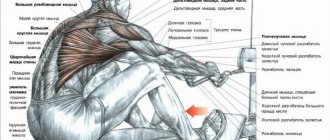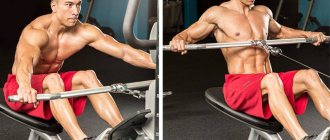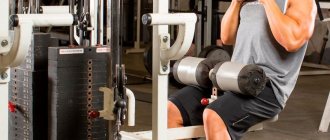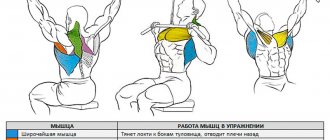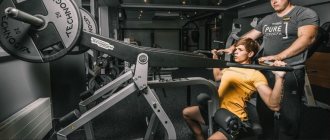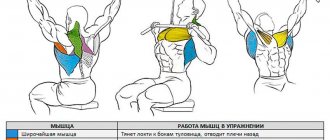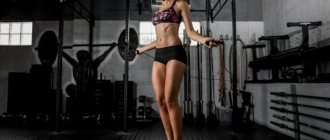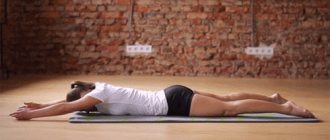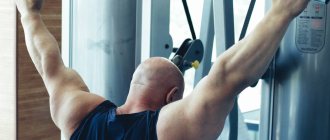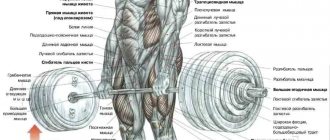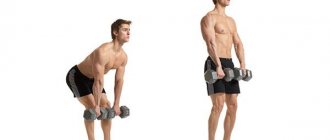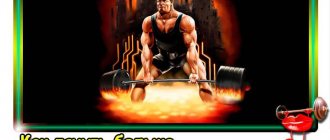What do we do to gain muscle mass in our back? That's right, we pull the barbell to the waist in a bent-over position, perform classic deadlifts, and pull ourselves up with weight. The horizontal block row is biomechanically reminiscent of a bent-over barbell row, but this exercise is not for building muscle, but for shaping what is already there. The movement is multi-joint, but due to the use of exercise machines, stabilizers and legs are turned off, and the abdominal muscles practically do not work. This helps maintain a certain shape, keep the waist thin, and develop the contours of the lats. That is why the horizontal block row while sitting and standing is a favorite exercise of competitive bodybuilders, and, oddly enough, women. It is difficult to achieve a triangular back shape with this movement unless you have a lot of mass. But tightening the “wings” so that there are no folds on the back is easy and relaxed.
The meaning of the exercise and muscle work
Horizontal rows in a pulley machine are one of the required exercises on the day when you train your back. By varying your grips, you can work your lats from all angles. This is very convenient when, with the help of basic exercises, you have already built up mass and want to give the muscles the desired shape.
During the exercise the following works:
- The latissimus muscles bear the main load.
- Biceps - Helps you pull weights by bending your elbows.
- Spinal extensor muscles. They are responsible for straightening the back.
- Additionally, the trapezius muscles, teres major, rhomboids, and rear deltoids are included.
If you do the exercise incorrectly, the biceps or lower back will work, and the lats will be the last to tighten. Therefore, pay special attention to technology.
Crossover Bench Press
If the first and second places in our top are occupied by the most popular basic exercises performed on blocks, then the third and fourth places are little-known movements.
However, they are extremely effective in stimulating muscle growth. True, they are more suitable for people with an average or even high level of training. For beginners, it is better to use similar movements with a barbell or dumbbells to gain weight.
Third place - a basic multi-joint exercise for the pectoral muscles - crossover bench press lying on a bench (horizontal or inclined upward).
In the starting position, you lie down on a bench strictly in the middle of the crossover frame, each hand directed towards the lower one-handed handle. Taking the handles in each hand, you need to raise your arms straight above your chest. From this position they begin to do the bench press.
This is a kind of analogue of the dumbbell bench press. But the crossover exercise has a number of advantages that dumbbells do not have:
- The pectoral muscles receive load throughout the entire range of motion
This happens due to the features of the block mechanism.
When performing dumbbell bench presses, the pectoral muscles rest in the upper phase of the movement. More precisely, they are loaded very lightly. Therefore, professional bodybuilders specifically additionally strain the pectoral muscles at the moment of straightening their arms.
A similar significant drawback is absent from the crossover bench press. Here, the more your arms are straightened, the more the load on the pectoral muscles increases.
- Unusual movement
The novelty effect makes the breasts work in a new way. This is additional stress and an impetus for further growth.
Technique
Seated pulley rows, also known as rowing rows, are performed using a special pulley machine. Usually the simulator has a lower and an upper block. The top one can be pulled behind the head or to the chest, and we will pull the bottom one to the belt.
Don’t be confused, rowing a barbell to the waist and rowing a horizontal block are two different things. The first exercise is basic mass-gaining. The second is more formative, it is done while sitting.
So, let's start doing the exercise:
- Set the desired weight (for men – 10 kg, for women – 5). Now we will do a warm-up with light weights.
- We rest our feet on special supports, bend them at the knees, and find a comfortable position (the angle can be from small to 90 degrees). Keep your back straight, with a natural arch in your lower back.
- We stretch our arms forward and clasp the pre-installed handle.
- We pull the weight towards ourselves until the body reaches a position perpendicular to the floor. From this point we begin to do repetitions.
- Straighten your shoulders, bringing your shoulder blades together, pull the handle towards your stomach. You should feel the load in your back, not your biceps. We will return to this later.
- When the handle touches your waist, hold this position for 1 second. In this position, your shoulder blades are retracted as much as possible.
- Then release the weight back. In the classical technique, the body remains motionless. If you perform the exercise by tilting your body forward following the weight, then you should not bend over too much and round your back. Even if the tiles of the machine have not completely lowered. During the entire exercise, the deflection in the lower back is maintained, and the shoulder blades remain pressed. The difference between the two techniques is described below.
When, during an exercise, you lean your body forward while lowering the weight, and then lean it back again during the next lift, you also force the back extensors to contract. These are long muscles that run along the spine. The latissimus muscles (namely, the exercise was originally intended for their development) are responsible for bringing the arms to the body. That is, the lats work precisely when you pull your elbows back.
Therefore, if your goal is the lats, fix your body in one position and work exclusively with your hands, without leaning forward with the weight. If you want to work your entire back, bending forward will help you stretch your muscles better before your next rep. But remember that in this case there will be a risk of injuring your lower back.
Do 10-12 reps in 3-4 sets with the working weight.
An alternative if there is no “right” simulator
Do you need to work out the center of your back, shoulders and chest, but the machine you are looking for is busy? Any mechanism can be replaced with an alternative solution. There will be no need to load the lumbar region. A regular bench with an adjustable back will solve the problem. Algorithm :
- Move the backrest 40-45 degrees.
- Place your knees on the horizontal part of the bench, facing the sloping back.
- Rest your chest and stomach against the back.
- Ask your neighbors for help (they should provide dumbbells prepared in advance).
- Pull the dumbbells to your chest.
- Slowly straighten your arms and repeat the exercise the required number of times.
How to choose a working weight
To correctly choose the weight with which your back muscles will grow, you need to listen carefully to yourself during the exercise:
- Take a light weight and do 4-5 reps with it. Add 5 kg, do 1-2 times. Add plates to the machine in this manner until you feel the load. If the load is felt, but is still light, move on to a step of 2.5 kg.
- Now do 12 repetitions. If you can't, rest for 3-4 minutes so that you can properly evaluate the weights again. A short break will not allow your muscles to replenish their energy reserves, and you will misinterpret your sensations.
- When you feel that your weight is normal, work. In the next workouts, add 2.5 kg, depending on your feelings. And don’t expect quick results, muscles grow slowly - be patient. Your persistence will be rewarded.
Crossover Curl
Biceps curls are a classic isolation exercise. It is part of almost any biceps complex.
This movement is good to complete the training of the biceps brachii muscle, because it contributes to its excellent blood supply (pumping).
Different types of handles allow you to work the biceps on the lower block in all sorts of ways: wide, narrow, reverse, neutral grip, or with each hand in turn.
In addition, exercises on the block can be done from various starting positions: sitting, standing, bending over or not.
People with average and advanced levels of training will benefit the most from this movement.
Basic mistakes
Horizontal rows in a block simulator, if performed incorrectly, will turn from a useful and effective exercise into a harmful and even dangerous one. By violating the technique, you risk tearing your back muscles, getting lumbar osteochondrosis, and pulling your biceps.
The technique was developed taking into account physiology and anatomy in order to minimize the risk of injury and pump up muscles.
- The back is round. Horizontal rows in a block machine involve static tension of the back extensor muscles. In a straightened position, the back does not receive a critical traumatic load, and in a rounded position, the lower back suffers greatly.
- Look down. You need to look forward so that the spine is in the right condition.
- We pull the weight with our hands. There are special exercises for biceps, why train them here? Pull the weight with your back. To do this, we first pull by bringing the shoulder blades together. We reduce them as much as possible, all the way. Then we bring the weight up with our hands. This way, starting from the back will eliminate the dominance of the biceps in this exercise.
- Excessive forward bending. You don't need to work your lower back, moving like a pendulum. The horizontal block pull is done not with the lower back, but with the lats.
- Jerks. We remember that you need to do the exercise slowly and thoughtfully. Feel every movement, listen to which muscles are working. After all, who, if not you, will do this? No one can do it except you.
- It is not a good idea to push your feet off the supports during the exercise. Because this is pure cheating. And a waste of energy. The weight is distributed between the muscles of the torso, and the back does not work.
Seated Crossover Press
All the benefits of the crossover bench press are the same as the seated press, the only difference being that it is a basic shoulder exercise. The main emphasis is on the middle and anterior deltoid muscles.
This movement will appeal to people with intermediate to advanced levels of fitness. By the way, professional bodybuilders also do it with great pleasure.
While performing seated presses, you can keep your elbows to the sides, then the load will shift more to the middle delta.
By bringing the elbows forward, in front of the body, the anterior delta works stronger.
It is also possible to press with each hand alternately.
Exercise options
You can pull the weight to different places with a narrow and wide grip, using different handles.
Grip Features
The classic gym offers us 3 options for handles that allow you to pull weights with three grips:
- Lower block row with a narrow grip, palms facing each other. In this case, the middle part of the latissimus muscles works.
- Wide grip row with palms facing in. This grip allows you to pump up the upper part of the latissimus muscles.
- Designed for lat pulldowns, the curved bar allows you to engage the outer lats by holding yourself with a wide grip.
Pull in different directions
Pulldowns of the lower block to different parts of the body force different parts of the back muscles to work. This feature is convenient to use to create an individual contour for your back:
- Pulling the lower block towards the waist allows you to load the middle part of the lats. In general, this movement option is standard and is recommended by most trainers. So, the block row can be one of the exercises in your back day. Another option for the name of the exercise is the pull-down of the lower block to the stomach.
- The groin pulldown will allow you to work the lower part of your lats. This is the most difficult version of the exercise, since the bottom is always weaker than the top (judge for yourself by the volume).
- Seated rows are a common option for beginners. Sometimes this can be a sign that you have taken on a lot of weight and are unable to complete the exercise, bringing it to the belt. If you pull towards your chest, then you know that the upper part of the lats swings more.
Let us remind you that the exercise is done while sitting, not standing. Therefore, most muscles are isolated. However, the legs are slightly tensed to prevent your pelvis from moving with the weight.
Tips for maximum efficiency
The muscle mass of the dorsal area requires regular physical activity to keep the anatomical structures in good shape. To diversify the training process, heavy basic techniques are combined with formative exercises that specifically target this area.
The following recommendations will increase the effectiveness of your classes and speed up progress:
- Using different grips. It is advisable to test all the options and select the most suitable set for yourself. It is recommended to alternate them at each workout. This will bring tangible benefits and make the process less boring and monotonous.
- Focusing on bringing your shoulder blades together. The movement of these bones with muscle structures, ligaments and tendon tissues is considered a decisive moment for the development of the spinal muscles. They work especially effectively when the arms are pulled back and down correctly.
- Movement of the elbow joints along the body. When performing deadlifts, they should be positioned at a minimum distance from the torso. This increases the efficiency of sports work.
- Smooth movement. When pulling weights, you can’t rush. Smooth movements accelerate the formation of neuromuscular connections. After pulling the block to the highest point of the amplitude, you must pause so that the muscles work statically.
To increase the effectiveness of traction on the abdomen, chest or chin of the lower block, it is recommended to use special straps that secure the hands. Devices are needed when working with heavy weights to relieve excess tension from the fingers, palms and wrist tendons.
When should you not deadlift?
When you have lower back pain, you can do this exercise by wearing a special orthopedic belt. It is necessary to protect the sacrolumbar spine from unnecessary load. Keep your lats pumping and your lower back safe.
If, while pulling the lower block, your arms hurt in the elbow area, stop doing it. When performing the exercise, the brachialis muscle is connected to the biceps, which can be pulled. It will take a long time to heal, causing discomfort only under significant load.
Extension of arms on a block
This is already the number one exercise for the triceps, performed on a block.
Technical simplicity and comfort with simultaneous high performance - all this provided him with nationwide love and recognition.
A huge number of handles (straight, v-shaped, rope, one-handed) allows you to choose the technique of movement for yourself, perform it with two hands or alternately with one.
This is a great option for pumping up the triceps for everyone.
Only beginners use a triceps pulley at the beginning of a triceps program, while advanced athletes use it as a warm-up exercise at the beginning of a triceps routine. Either as a “finisher” in the middle or at the end of a triceps workout.
Additional recommendations
To increase the effectiveness of your training, you need to avoid basic mistakes. Among them:
- Jerks. The lower block must be pulled slowly and thoughtfully, feeling the work of the core muscles.
- Performing a bending exercise with excessive forward movement. It should be remembered that the latissimus muscles should work, not the lower back.
- Pushing off the platform with your feet. This results in a loss of efficiency as the load is distributed across all muscles.
- Hand weight pull. There are other complexes for biceps and triceps; here the back should be included as much as possible.
- Looking down. It is necessary to look straight so that the spine does not receive excessive load.
The number of repetitions and sets depends on the physical condition and preparedness of the athlete. You should start with 10–12 times in 3–4 approaches, gradually increasing the indicators and the weight used. Horizontal rows with a reverse grip or one arm are a complication of the exercise that is recommended for professional and experienced athletes. For girls, a triangular back is not a standard of beauty, not counting weightlifters. To tighten the latissimus muscles and tone them, women only need to perform 10-15 repetitions in 3 sets with minimal weight.
The exercise should be performed slowly, without jerking
You cannot push off the platform with your feet, this leads to a decrease in efficiency
The latissimus muscles should work, not the lower back
